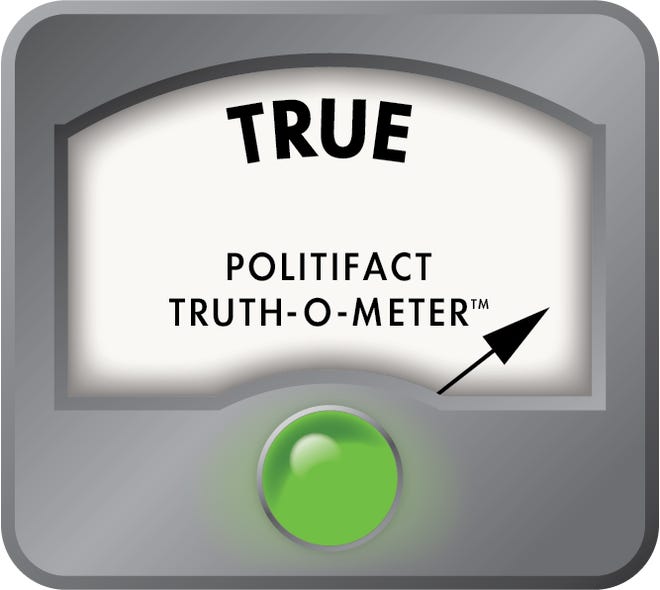Fact check: Yes, nearly 25 cents of every dollar spent via SNAP goes back to farmers
Howdy,
This article reminds us that farmers produce the food that is used to feed hungry people. That applies to the SNAP program domestically, or USAID internationally. In both cases, price depressing surplus foods are used to feed hungry people. Few good things happen when mean and dumb work together.
All the best,
Jon K. Hansen, President
Nebraska Farmers Union
john
(402) 476-8815 Office (402) 580-8815 Cell
1305 Plum Street, Lincoln, NE 68502
POLITIFACT WISCONSIN
Fact check: Yes, nearly 25 cents of every dollar spent via SNAP goes back to farmers
Milwaukee Journal Sentinel
- The Supplemental Nutrition Assistance Program, or SNAP, provides low-income people with aid to buy certain foods at authorized retailers.
- According to the U.S. Department of Agriculture’s Economic Research Service, farms made 24.3 cents for every dollar spent on food at home in 2023.
- SNAP dollars are restricted to food only and largely can’t be spent at restaurants. Food purchasing habits of SNAP and non-SNAP buyers are similar, research shows.
- Assuming, then, that a SNAP recipient is an average consumer, the statistic from the Economic Research Service applies, making Hong’s claim accurate.
The Supplemental Nutrition Assistance Program, better known as SNAP, has been in the news a lot since President Donald Trump’s “one big beautiful bill” advanced through Congress and was signed into law.
SNAP, which is called FoodShare in Wisconsin, is the federal program that provides low-income people with cash assistance to buy certain foods at authorized retailers. It has long been a lightning rod among politicians because of disagreements over how much aid the federal government should administer.
In the new law, Republicans expanded the number of Americans who need to meet work requirements to qualify for the aid, and shifted some of the costs of the program onto states. These changes could reduce SNAP benefits for thousands of Wisconsin residents and cost taxpayers tens of millions of dollars in the coming years, according to estimates from the state health department and the Urban Institute, a Washington, D.C.-based think-tank.
Many people voiced concern about the cuts, including Wisconsin state Rep. Francesca Hong, a Democrat from Madison.
In a series of X posts June 12, Hong argued it wouldn’t be only families receiving food aid that would be hurt. One example that caught our eye was about the benefits of the program for farmers.
“Nearly 25 cents of every $1 spent via SNAP goes to farmers and ranchers,” Hong wrote.
Though the law has since been passed, we thought this claim was still worth a look. How much money are farmers getting as a result of SNAP?
Let’s take a look.
USDA: In 2023, about 25 cents of every food-at-home dollar went to farmers
Asked to back up her claim, Hong’s office provided a chart published earlier this year by the U.S. Department of Agriculture’s Economic Research Service. The chart shows that in 2023, farm establishments made 24.3 cents for every dollar spent on food at home, including at grocery stores and supermarkets.
A quick reminder: SNAP dollars are restricted to food only and, for the most part, can’t be spent at restaurants. That makes the food-at-home dollar the focus here.
Back to the 24.3 cents — it’s an average of all people and all food purchased for at-home consumption, said Paul Mitchell, director of the Renk Agribusiness Institute at UW-Madison. In other words, it’s not specific to SNAP recipients.
But research shows SNAP and non-SNAP households have similar purchasing habits for food they eat at home. So, assuming SNAP recipients are average consumers, Hong’s claim is accurate, Mitchell said.
There is some nuance here, because the farmer’s share differs by type of food. In general, the less processed the food is and the fewer hands that are involved in getting it to the consumer, the more the farmer receives, Mitchell said.
For example, according to data from the Economic Research Service compiled by the National Farmers Union, a farmer would receive 50 cents on the dollar for apples and more than 60 cents on the dollar for eggs. That drops to one cent on the dollar for a wheat bagel and less than that for corn cereal.
But again, the Economic Research Service’s statistic that farms made 24.3 cents for every dollar spent on food at home is an average of all types of food.
Dawn Thilmany, a professor of agriculture and resource economics at Colorado State University, said Hong’s claim is accurate and may even be a slightly conservative estimate when accounting for SNAP dollars spent at farmers’ markets or food retailers that source locally.
Thilmany also pointed to Double Up programs, meant to incentivize healthy eating by matching SNAP recipients’ dollars on fruits and vegetables at certain farmers markets. For example, Dane County’s Double Dollars program matches SNAP dollars up to $20 at area farmers markets, and vendors are fully reimbursed.
That makes the money more likely to go back to where farmers farm, Thilmany said. She called it a win for health and for the economy.
Our ruling
Hong claimed that nearly 25 cents of every dollar spent via SNAP goes to farmers and ranchers.
Recent data from the USDA’s Economic Research Service backs that up, and experts confirmed its accuracy.
We rate this claim True.
Sources
Congress.gov, H.R.1 – One Big Beautiful Bill Act, accessed July 29, 2025
U.S. Department of Agriculture Food Nutrition Service, Supplemental Nutrition Assistance Program (SNAP), accessed July 29, 2025
Milwaukee Journal Sentinel, “Federal budget could shift as much as $300 million in costs to Wisconsin for SNAP benefits,” May 23, 2025
Urban Institute, “Cuts to SNAP in the One Big Beautiful Bill Act Would Widen the Persistent Gap between Benefits and Food Costs,” July 16, 2025
USDA Economic Research Service, “Farm establishments received nearly a quarter of each food-at-home dollar in 2023,” Feb. 3, 2025
USDA Food and Nutrition Service, “What can SNAP buy?” accessed July 29, 2025
USDA Food and Nutrition Service, “SNAP Restaurant Meals program,” accessed July 29, 2025
Email exchange with Paul Mitchell, director of the Renk Agribusiness Institute at UW-Madison
USDA Food and Nutrition Service, Foods typically purchased by Supplemental Nutrition Assistance Program (SNAP) households, November 2016
Food Research and Action Center, Research Brief: SNAP consumer choice, May 2024
University of Kentucky Center for Poverty Research, SNAP and Food Consumption, Jan. 16, 2014
National Farmers Union, The Farmer’s Share, accessed July 29, 2025
Email exchange with Dawn Thilmany, professor of agriculture and resource economics at Colorado State University
Community Action Coalition for South Central Wisconsin, Double Dollars Madison & Dane County, accessed July 29, 2025

